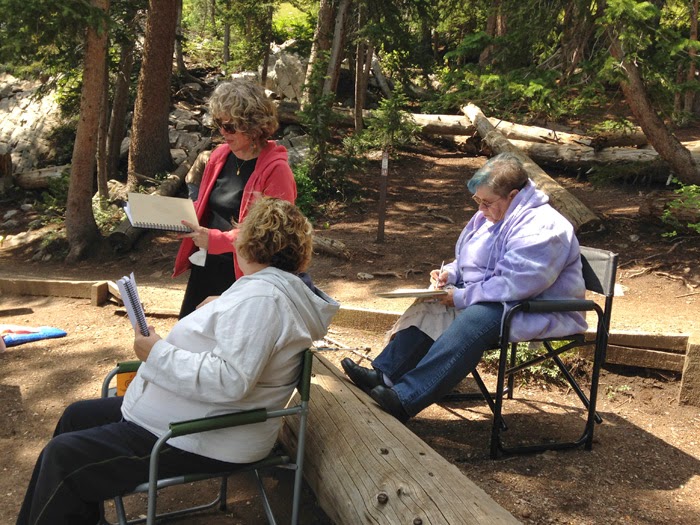Eight artists braved the beauty of La Caille, a restaurant located
at the base of the Wasatch Mountains in Sandy, Utah (someone
had to suffer...ha-ha).
at the base of the Wasatch Mountains in Sandy, Utah (someone
had to suffer...ha-ha).
Painting on the grounds of La Caille was like stepping onto
the pages of a story book. It's rolling hills, stoney paths, water
fountains and beautiful flowers were stunning. I half expected
to see a princess walk out from one of the cottage-like structures.
There were screaming peacocks, swans, geese, rabbits, roosters
and other critters.
the pages of a story book. It's rolling hills, stoney paths, water
fountains and beautiful flowers were stunning. I half expected
to see a princess walk out from one of the cottage-like structures.
There were screaming peacocks, swans, geese, rabbits, roosters
and other critters.
It was like being in a fairy tale. Perfect for plein air painting!
We started out at 9:00 am, found individual places to set up
and began our workshop.
Today was all about learning to control a palette knife.
It would have been easy to use a brush, but I decided to
have the students focus their efforts solely on knife work.
It was a challenge for them to find the balance between
not using enough paint and spreading too much paint on
their canvas.
There were many details in the surroundings (like hanging
flower baskets, ducks and garden sculpture), and we found
it hard to remember to simplify our compositions. It was a
real test in learning how to edit!
The first assignment was to complete a value study
(monochromatic) of each composition.
After the value studies had been completed, we began our
color studies. May I just say that it felt like there was never
enough time to complete any of the paintings in this four-hour
workshop!
Having a value study to use as a reference was helpful when
the art principle of color was introduced. We could look back
and forth between the value study and the color study to make
sure the values were similar.
Introducing color added a level of complexity to our work.
Selecting a value was
relatively easy when we were painting
with only one color. Having to determine the value of each new
color required concentration and accurate observation!
There was a lot of scraping and re-applying of the paint!
I was proud of the way in which the students worked.
They didn't complain, they stayed focused and they
produced some great work!
When I first began to plein air paint with a knife, my
results were disastrous! I thought I was a pretty good
artist but when I got out in the field (literally) and
compared my first plein air paintings to those of the
professionals in my group, I was embarrassed at the
results of my efforts. I threw my first few plein air
paintings in the dumpster (that was a mistake),
however I stuck with it, improved my skills and I am
seeing some success now.
It was worth the effort!
Think of today's workshop as an exercise. Plein air
painting is like everything else; it takes practice! Read
some books on plein air and palette knife painting,
take a few classes, but mostly - just paint. Add your
brushes back into your plein air supplies with your
palette knives. Combine the control of a paint brush
with the spontaneity and liveliness of your palette knife.
Keep your plein air paintings in a box somewhere
and in a year or so - get the old paintings out and
see how much you have improved. Have some fun!
Happy painting!!




















































